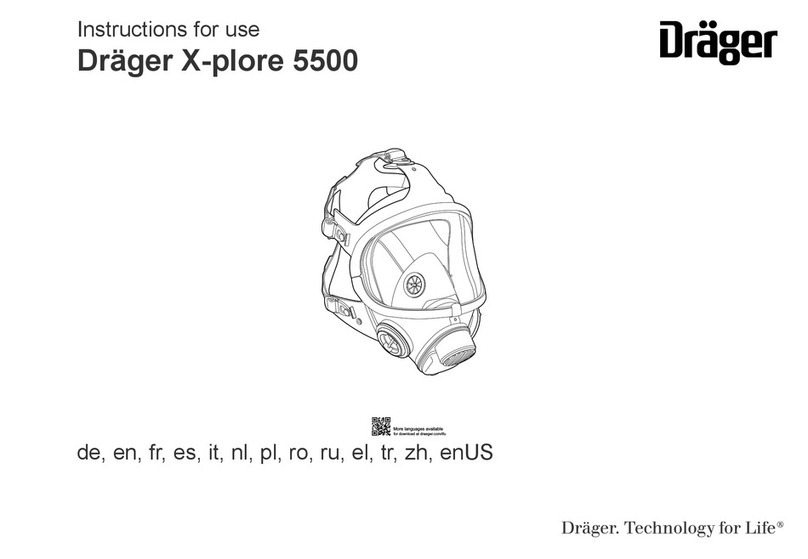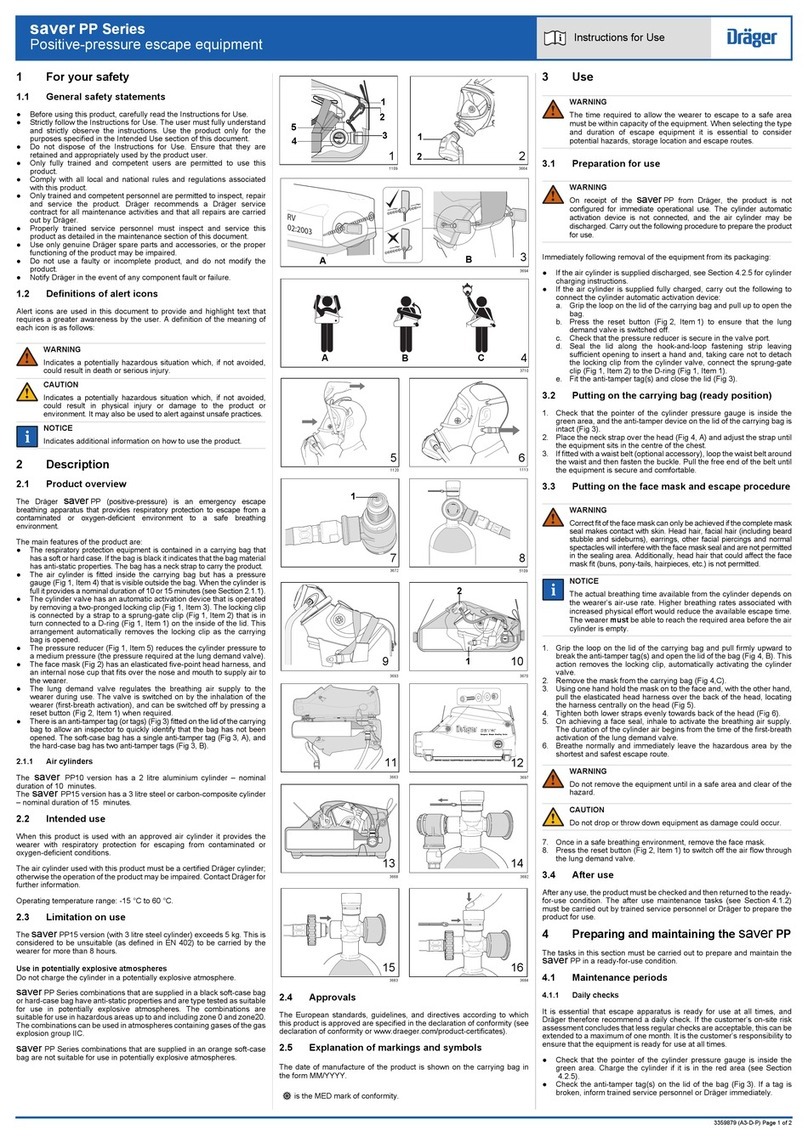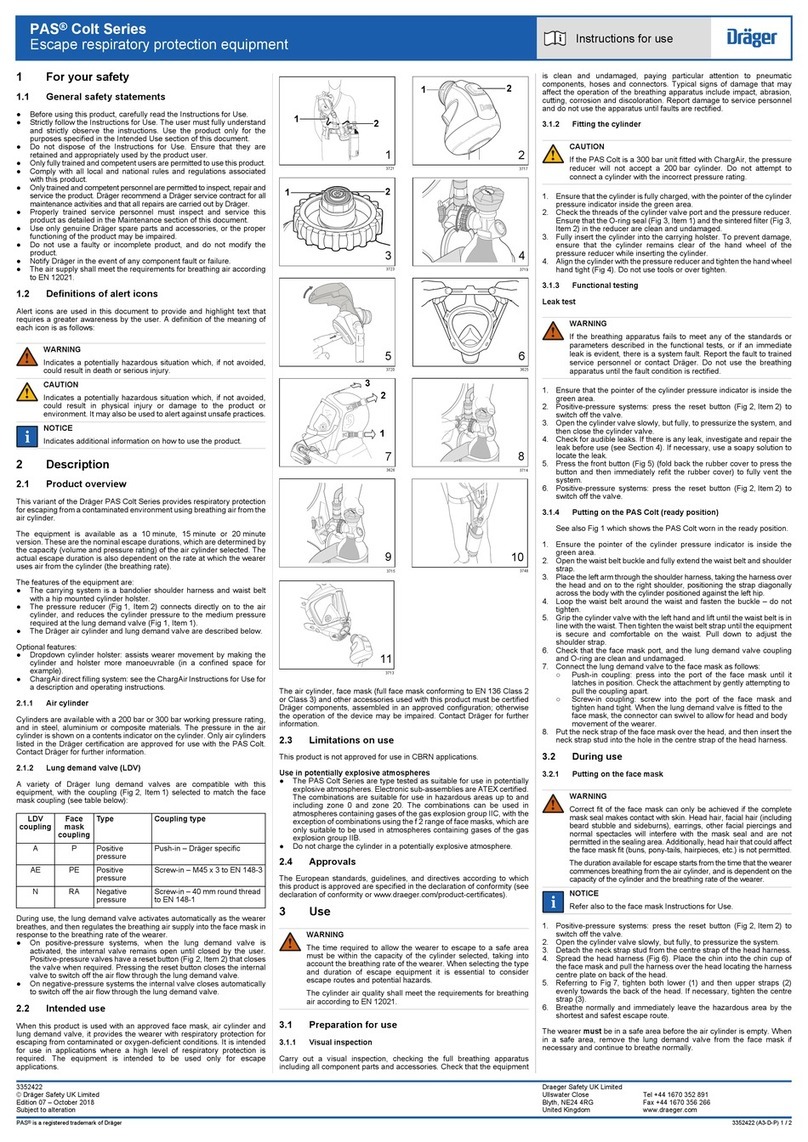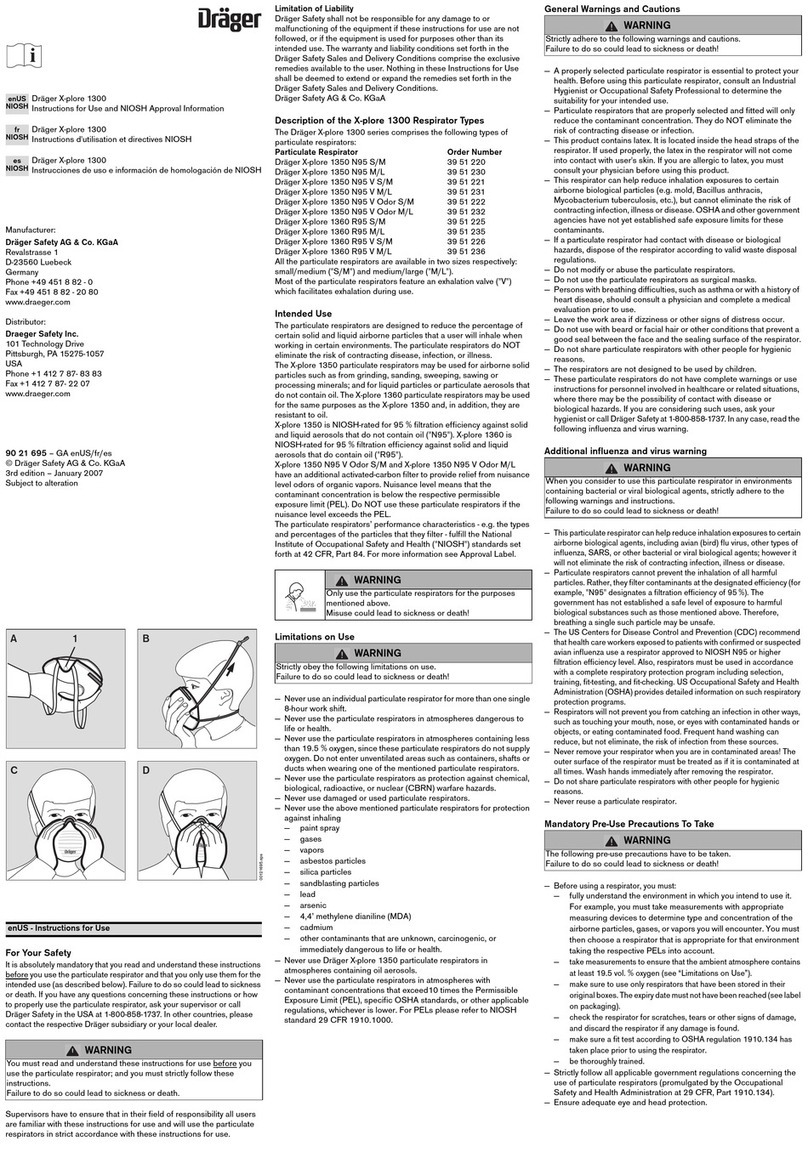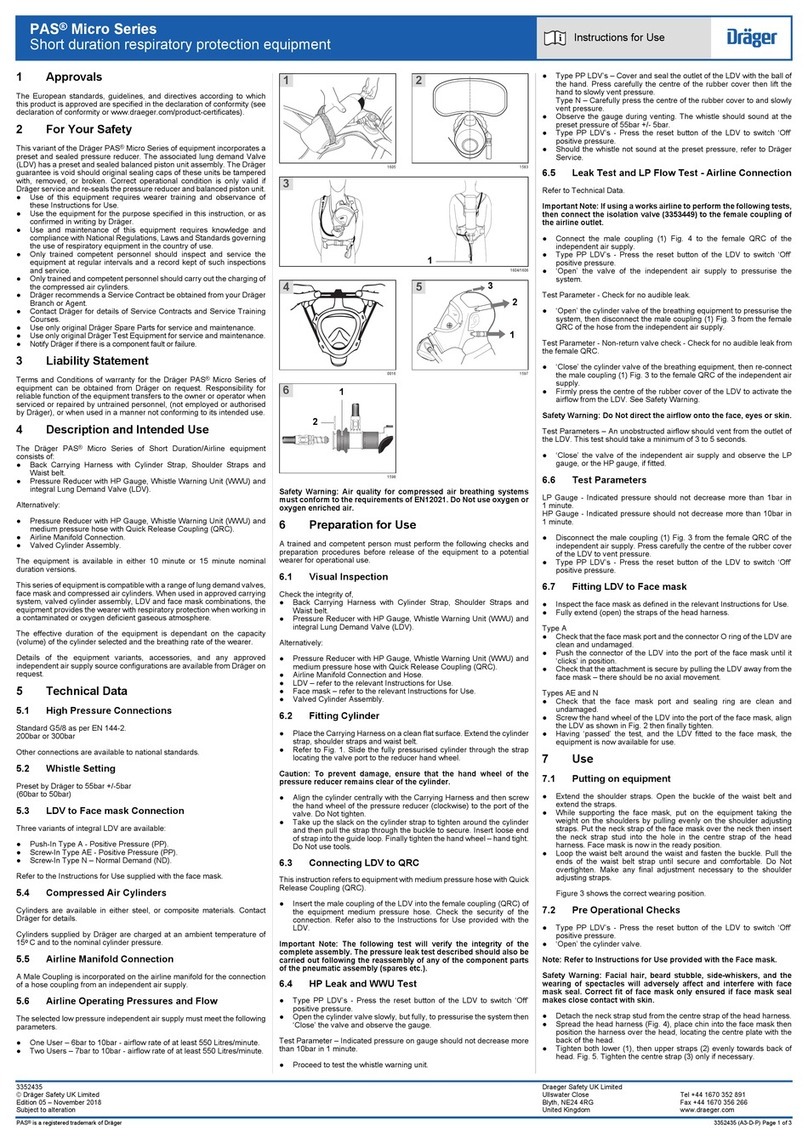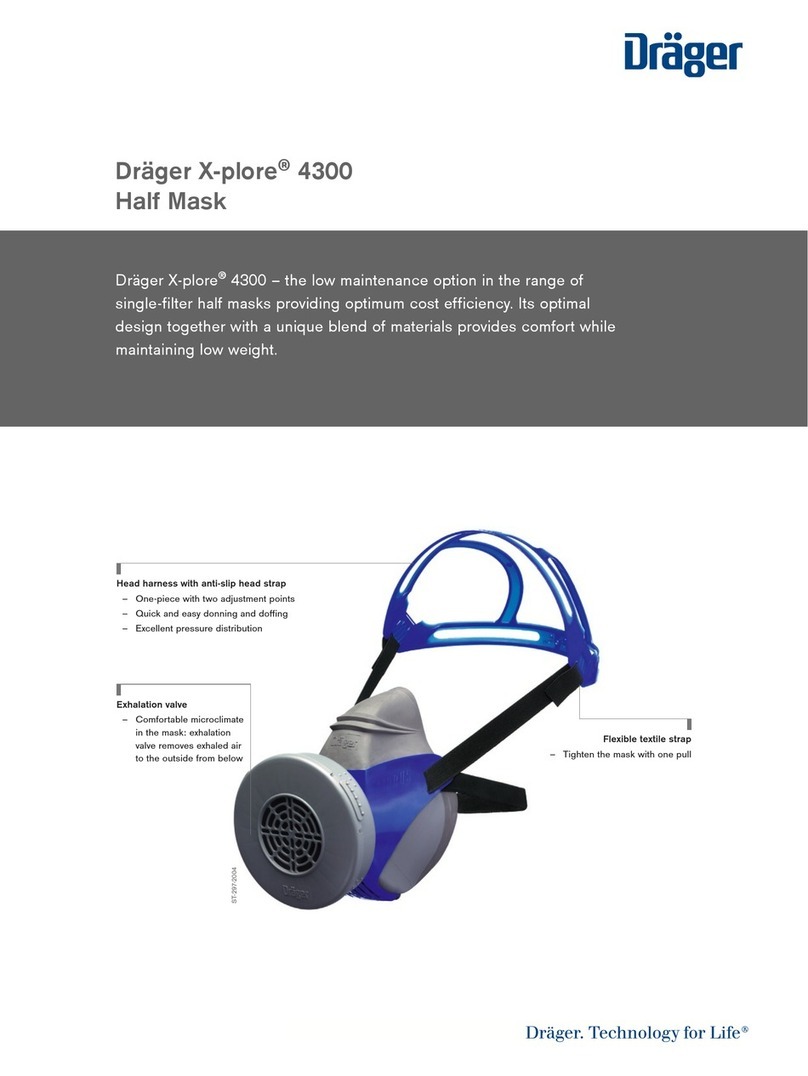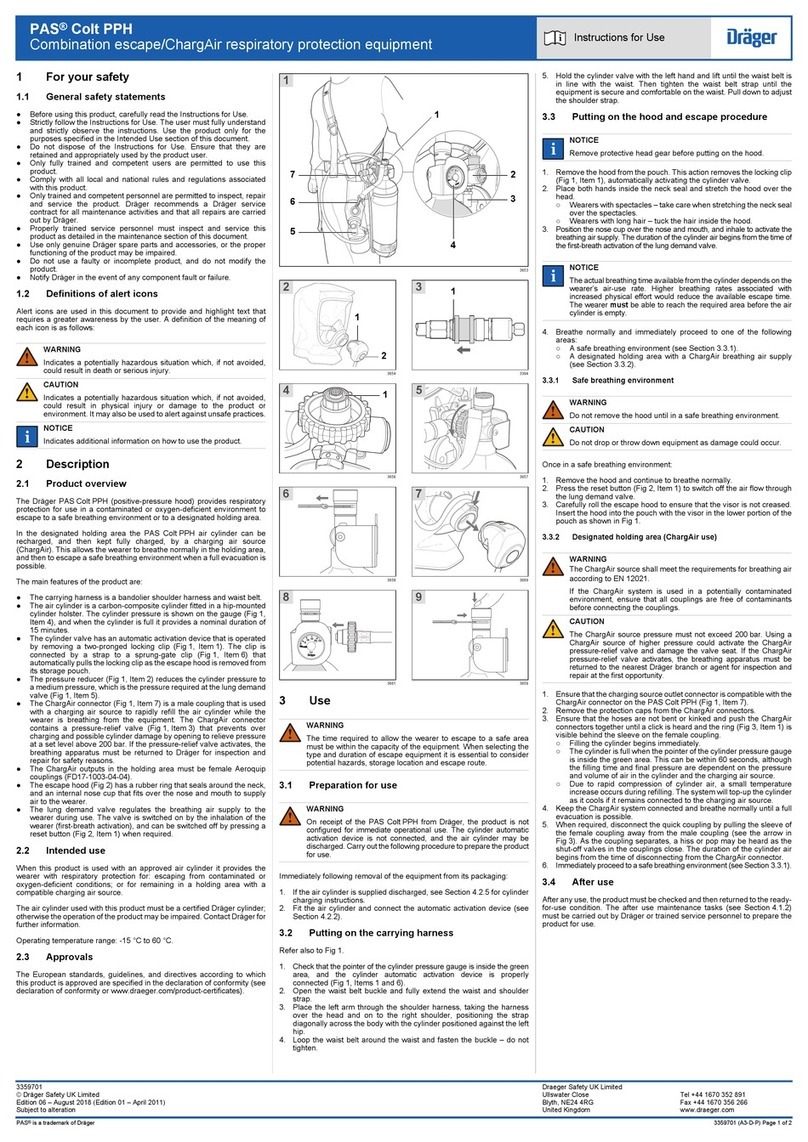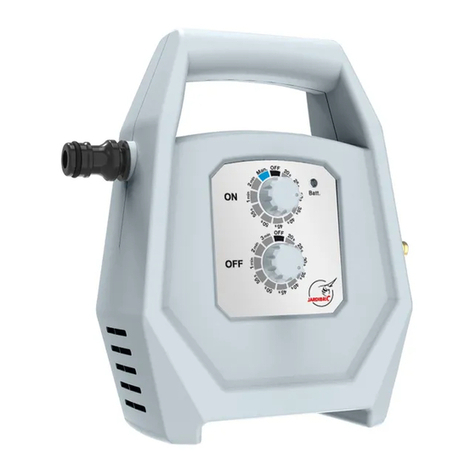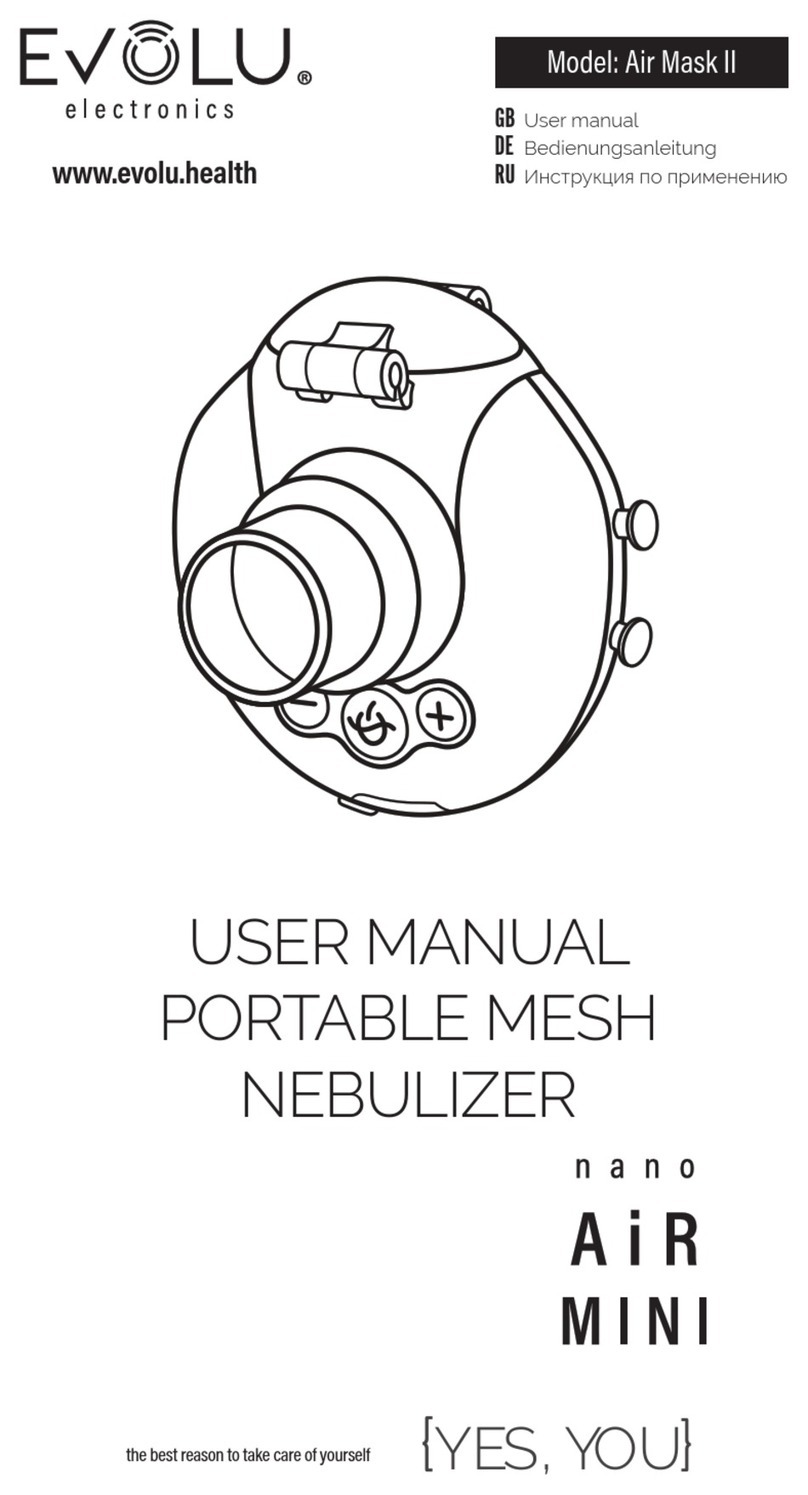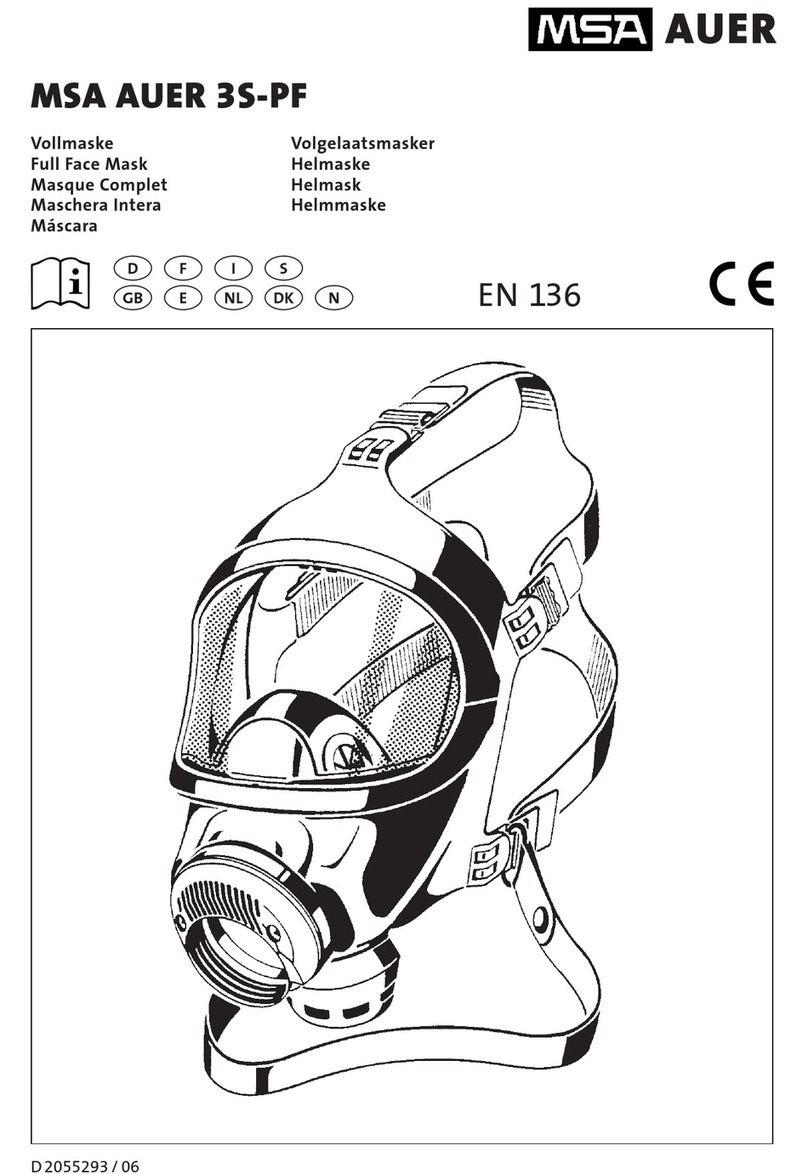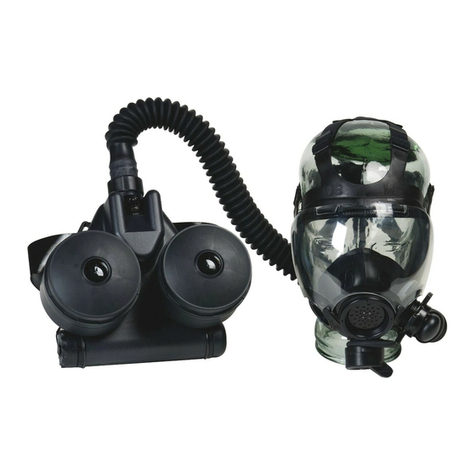
PAS® is a registered trademark of Dräger 3352428 (A3-D-P) 1 / 2
3352428
© Dräger Safety UK Limited
Edition 12 – February 2022
Subject to alteration
Draeger Safety UK Limited
Ullswater Close Tel +44 1670 352 891
Blyth, NE24 4RG Fax +44 1670 356 266
United Kingdom www.draeger.com
PAS® Colt series
Escape SCBA respiratory protection equipment Instructions for use
1 For your safety
1.1 General safety statements
● Before using this product, carefully read the Instructions for Use.
● Strictly follow the Instructions for Use. The user must fully understand
and strictly observe the instructions. Use the product only for the
purposes specified in the Intended Use section of this document.
● Do not dispose of the Instructions for Use. Ensure that they are
retained and appropriately used by the product user.
● Only fully trained and competent users are permitted to use this
product.
● Comply with all local and national rules and regulations associated
with this product.
● Only trained and competent personnel are permitted to inspect, repair
and service the product. Dräger recommends a Dräger service
contract for all maintenance activities and that all repairs are carried
out by Dräger.
● Properly trained service personnel must inspect and service this
product as detailed in the maintenance section of this document.
● Use only genuine Dräger spare parts and accessories, or the proper
functioning of the product may be impaired.
● Do not use a faulty or incomplete product, and do not modify the
product.
● Notify Dräger in the event of any component fault or failure.
● Before occupational use of this respirator a written respiratory
protection program must be implemented meeting all the local
government requirements. In the United States employers must
comply with OSHA 29 CFR 1910.134 which includes medical
evaluation, training, and fit testing.
1.2 Definitions of alert icons
Alert icons are used in this document to provide and highlight text that
requires a greater awareness by the user. A definition of the meaning of
each icon is as follows:
WARNING
Indicates a potentially hazardous situation which, if not avoided, could
result in death or serious injury.
CAUTION
Indicates a potentially hazardous situation which, if not avoided, could
result in physical injury or damage to the product or environment. It may
also be used to alert against unsafe practices.
NOTICE
Indicates additional information on how to use the product.
2 Description
2.1 Product overview
This variant of the Dräger PAS® Colt Series provides respiratory protection
for escaping from a contaminated environment using breathing air from the
air cylinder (self-contained breathing apparatus – SCBA).
The features of the equipment are:
● The carrying system is a bandolier shoulder harness and waist belt.
● The lung demand regulator (LDR) has a reset button (Fig 1, Item 1)
that switches off the air flow through the regulator, and a purge
button (Fig 1, Item 2) that can be used vent the pneumatic system. The
holder (Fig 2, Item 1) provides a stowage point to protect the regulator
coupling and O-ring against damage when it is not fitted in the face
mask.
● The first-stage regulator (Fig 2, Item 2) has an anti-vibration strap fitted
that is use to prevent loosening of the connector hand wheel.
● The hip-mounted cylinder holster has a drop-down facility that can
assist wearer movement by making the cylinder and holster more
manoeuvrable (in a confined space for example).
● The remaining pressure in the air cylinder is shown on a contents
indicator on the cylinder.
● A thigh strap is available as an accessory.
2.2 Intended use
When this product is used with an approved face mask and air cylinder, it
provides the wearer with respiratory protection for escaping from
contaminated or oxygen-deficient conditions. It is intended for use in
applications where a high level of respiratory protection is required,
including IDLH (immediately dangerous to life and health) atmospheres.
The air cylinder, face mask and other accessories used with this product
must be certified Dräger components, assembled in an approved
configuration; otherwise the operation of the device may be impaired. It is
essential that flushing and non-flushing face masks and lung demand
regulators should not be mixed (i.e. only a flushing-type face mask should
be used with a flushing-type lung demand regulator). Contact Dräger for
further information.
2.3 Limitations on use
This product is not approved for use in CBRN applications.
2.4 Approvals
The PAS® Colt Series of escape respiratory protection equipment
conforms to the requirements of NIOSH. This product is approved for use
as a self-contained escape respirator, and must only be used in
conjunction with compressed-air cylinders approved by NIOSH.
3 Use
WARNING
The time required to allow the wearer to escape to a safe area must be
within the capacity (volume) of the cylinder selected, taking into account
the breathing rate of the wearer. When selecting the type and duration of
escape equipment it is essential to consider the potential hazards and
probable escape routes.
The cylinder air quality shall meet the requirements for breathing air
according to CGA G-7.1 Grade D or higher quality.
3.1 Preparation for use
3.1.1 Visual inspection
Carry out a visual inspection, checking the full breathing apparatus
including all component parts and accessories. Check that the equipment
is clean and undamaged, paying particular attention to pneumatic
components, hoses and connectors. Typical signs of damage that may
affect the operation of the breathing apparatus include impact, abrasion,
cutting, corrosion and discoloration. Report damage to service personnel
and do not use the apparatus until faults are rectified.
3.1.2 Fitting the cylinder
1. Ensure that the cylinder is fully charged, with the pointer of the cylinder
pressure indicator inside the green area.
2. Check that the threads of the valve port and the regulator hand wheel
are undamaged, and the O-ring is in position and undamaged.
3. Fully insert the cylinder into the carrying holster.
CAUTION
To prevent damage, ensure that the cylinder remains clear of the hand
wheel of the first-stage regulator while inserting the cylinder.
4. Align the cylinder with the regulator and tighten the hand wheel hand
tight (Fig 3).
5. Pull the anti-vibration strap over the top of the cylinder valve (Fig 4).
3.1.3 Functional testing
WARNING
If the breathing apparatus fails to meet any of the standards or
parameters described in the functional tests, or if an immediate leak is
evident, there is a system fault. Report the fault to trained service
personnel or contact Dräger. Do not use the breathing apparatus until the
fault condition is rectified.
Leak test
1. Ensure that the pointer of the cylinder pressure indicator is inside the
green area.
2. Press the reset button (Fig 1, Item 1) of the lung demand regulator to
switch off the positive pressure.
3. Open the cylinder valve slowly, but fully, to pressurize the system and
then close the valve. There should be no audible leak. If there is any
leak, investigate and repair the leak before use. If necessary, use a
soapy solution to locate the leak.
4. Press the purge button (Fig 1, Item 2) to vent the system.
5. Press the reset button (Fig 1, Item 1) to switch off the positive
pressure.
3.1.4 Putting on the PAS® Colt (ready position)
Refer also to Fig 2 which shows the PAS® Colt worn in the ready position.
1. Ensure that the pointer of the cylinder pressure indicator is inside the
green area.
2. Open the waist belt buckle and fully extend the waist and shoulder
strap.
3. Place the left arm through the shoulder harness, taking the harness
over the head and on to the right shoulder, positioning the strap
diagonally across the body with the cylinder positioned against the left
hip.
4. Loop the waist belt around the waist and fasten the buckle – do not
tighten.
5. Grip the cylinder valve with the left hand and lift until the waist belt is in
line with the waist. Then tighten the waist belt strap until the equipment
is secure and comfortable on the waist. Pull down to adjust the
shoulder strap.
6. Inspect the face mask as defined in the relevant Instructions for Use.
7. Check that the face mask port and the regulator O-ring are clean and
undamaged.
8. Remove the lung demand regulator from the holder and press it into
the port of the face mask until it latches in position. Check the
attachment by gently attempting to pull the coupling apart.
9. Put the neck strap of the face mask over the head, and then insert the
neck strap stud into the hole in the centre strap of the head harness.
3.2 During use
3.2.1 Putting on the face mask and escape procedure
WARNING
Correct fit of the face mask can only be achieved if the complete face mask
seal makes contact with skin. Head hair, facial hair (including beard stubble
and sideburns), earrings, other facial piercings and normal spectacles will
interfere with the face mask seal and are not permitted in the sealing area.
Additionally, head hair that could affect the face mask fit (buns, pony-tails,
hairpieces, etc.) is not permitted.
NOTICE
Refer also to the face mask Instructions for Use.
1. Press the reset button (Fig 1, Item 1) of the lung demand regulator to
switch off the positive pressure.
2. Open the cylinder valve (counterclockwise) slowly, but fully, to
pressurize the system.
NOTICE
After storage at temperatures below 32 °F (0 °C) leakage may be observed
when the cylinder valve is initially opened due to ice formation.
► If leakage is observed from the lung demand regulator: Press the front
button (Fig 1, Item 3) to allow a rush of air to pass through the lung
demand regulator and then quickly press the reset button (Fig 1, Item
1) to switch off the positive pressure. Resume normal operation.
► In the event that leakage still occurs, remove the breathing apparatus
from service and report the fault to trained service personnel or
contact Dräger.
3. Detach the neck strap stud from the center strap of the head harness.
4. Spread the head harness (Fig 5). Place the chin into the chin cup of
the face mask and pull the harness over the head locating the harness
center plate on back of the head.
5. Referring to Fig 6, tighten both lower (1) and then upper straps (2)
evenly towards back of the head. If necessary, tighten the center
strap (3). The wearer’s first inhalation after achieving a face seal will
automatically switch on the air supply into the face mask.
WARNING
The duration of the cylinder air begins from the time of the first-breath
activation of the lung demand regulator.
Dräger strongly advise against using the purge button (Fig 1, Item 2) or
the front button (Fig 1, Item 3) during an escape. Using either button
would use air from the cylinder and reduce the time available for escape.
6. Immediately leave the hazardous area by the shortest and safest
escape route.
The wearer must be in a safe area before the air cylinder is empty. When
in a safe area, remove the lung demand regulator from the face mask if
necessary and continue to breathe normally.
3.2.2 Drop-down cylinder holster
● To release the drop-down cylinder holster:
a. Hold the cylinder valve with the left hand and, with the right hand,
press and hold the red button to open the locking
mechanism (Fig 7).
b. Lift the cylinder and holster clear of the locking mechanism and
then release the red button (Fig 8).
c. Lower the cylinder until it is supported by the harness
straps (Fig 9). The holster is held by two harness straps, one fixed
and one adjustable.
d. Hold the cylinder valve to move the cylinder and holster as
required.
● To reconnect the drop-down cylinder holster, align and press the roller
on the holster into the locking mechanism.
3629
1
1
2 3
3690
2
1
2
3630
3
3631
4
3625
5
3626
6
2
1
3
'
3000 PSI
EMPTY FUL
14
1234
USE
NO
OIL
3632
7
'
3000 PSI
EMPTY FUL
14
1234
USE
NO
OIL
3633
8
'
3000PSI
EMPTY FUL
14
1234
USE
NO
OIL
3634
9

